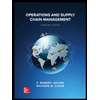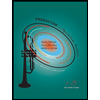Swearingen and McDonald, a small furniture manufacturer, produces fine hardwood tables and chairs. Each product must go through three stages of the manufacturing process: assembly, finishing, and inspection. Each table requires 12 hours of assembly, 20 hours of finishing, and 2 hours of inspection. Each chair requires 4 hours of assembly, 16 hours of finishing, and 3 hours of inspection. The profit per table is $150 while the profit per chair is $100. Currently, each week there are 300 hours of assembly time available, 220 hours of finishing time, and 30 hours of inspection time. To keep a balance, the number of chairs produced should be at least twice the number of tables. Also, the number of chairs cannot exceed 6 times the number of tables. (You may use QM-software for this problem. All the detailed output should be displayed). a) Formulate this as a linear programming problem. Carefully define all decision variables. b) Show the graph of the feasible region indicating all the relevant corner points c) Find the optimal solution to this LP and find the maximum profits.
Swearingen and McDonald, a small furniture manufacturer, produces fine hardwood tables and chairs. Each product must go through three stages of the manufacturing process: assembly, finishing, and inspection. Each table requires 12 hours of assembly, 20 hours of finishing, and 2 hours of inspection. Each chair requires 4 hours of assembly, 16 hours of finishing, and 3 hours of inspection. The profit per table is $150 while the profit per chair is $100. Currently, each week there are 300 hours of assembly time available, 220 hours of finishing time, and 30 hours of inspection time. To keep a balance, the number of chairs produced should be at least twice the number of tables. Also, the number of chairs cannot exceed 6 times the number of tables. (You may use QM-software for this problem. All the detailed output should be displayed). a) Formulate this as a linear programming problem. Carefully define all decision variables. b) Show the graph of the feasible region indicating all the relevant corner points c) Find the optimal solution to this LP and find the maximum profits.
Practical Management Science
6th Edition
ISBN:9781337406659
Author:WINSTON, Wayne L.
Publisher:WINSTON, Wayne L.
Chapter2: Introduction To Spreadsheet Modeling
Section: Chapter Questions
Problem 20P: Julie James is opening a lemonade stand. She believes the fixed cost per week of running the stand...
Related questions
Question
100%

Transcribed Image Text:ythos.content.blackboardcdn.com/5c1c67a3c99fc/2929686?X-Blackboard-Expiration=D1606219200000&X
1/ 1
QUESTION 1
Swearingen and McDonald, a small furniture manufacturer, produces fine hardwood tables and
chairs. Each product must go through three stages of the manufacturing process: assembly,
finishing, and inspection. Each table requires 12 hours of assembly, 20 hours of finishing, and 2
hours of inspection. Each chair requires 4 hours of assembly, 16 hours of finishing, and 3 hours
of inspection. The profit per table is $150 while the profit per chair is $100. Currently, each week
there are 300 hours of assembly time available, 220 hours of finishing time, and 30 hours of
inspection time. To keep a balance, the number of chairs produced should be at least twice the
number of tables. Also, the number of chairs cannot exceed 6 times the number of tables. (You
may use QM-software for this problem. All the detailed output should be displayed).
a) Formulate this as a linear programming problem. Carefully define all decision variables.
b) Show the graph of the feasible region indicating all the relevant corner points
c) Find the optimal solution to this LP and find the maximum profits.
QUESTION 2
A community farm has 6000 square kilometers of land available to plant wheat and millet. Each
kilometer square of wheat requires 9 gallons of fertilizer and insecticide and 4 hour of labor to
harvest. Each square kilometer of millet requires 3 gallons of fertilizer and insecticide and 1 hour
of labor to harvest. The community has at most 40,500 gallons of fertility and insecticide and at
most 5250 hours of labor for harvesting. If the profits per square kilometer are $60 for wheat and
$40 for millet, how many square kilometers of each crop should the community plant in order to
maximize profits? What is the maximum profit? Hint: x is the number of square kilometers of
wheat and y is the number of square kilometers of millet.
(A complete solution is required for this problem - No software)
a
Expert Solution
This question has been solved!
Explore an expertly crafted, step-by-step solution for a thorough understanding of key concepts.
This is a popular solution!
Trending now
This is a popular solution!
Step by step
Solved in 4 steps with 3 images

Knowledge Booster
Learn more about
Need a deep-dive on the concept behind this application? Look no further. Learn more about this topic, operations-management and related others by exploring similar questions and additional content below.Recommended textbooks for you

Practical Management Science
Operations Management
ISBN:
9781337406659
Author:
WINSTON, Wayne L.
Publisher:
Cengage,

Operations Management
Operations Management
ISBN:
9781259667473
Author:
William J Stevenson
Publisher:
McGraw-Hill Education

Operations and Supply Chain Management (Mcgraw-hi…
Operations Management
ISBN:
9781259666100
Author:
F. Robert Jacobs, Richard B Chase
Publisher:
McGraw-Hill Education

Practical Management Science
Operations Management
ISBN:
9781337406659
Author:
WINSTON, Wayne L.
Publisher:
Cengage,

Operations Management
Operations Management
ISBN:
9781259667473
Author:
William J Stevenson
Publisher:
McGraw-Hill Education

Operations and Supply Chain Management (Mcgraw-hi…
Operations Management
ISBN:
9781259666100
Author:
F. Robert Jacobs, Richard B Chase
Publisher:
McGraw-Hill Education


Purchasing and Supply Chain Management
Operations Management
ISBN:
9781285869681
Author:
Robert M. Monczka, Robert B. Handfield, Larry C. Giunipero, James L. Patterson
Publisher:
Cengage Learning

Production and Operations Analysis, Seventh Editi…
Operations Management
ISBN:
9781478623069
Author:
Steven Nahmias, Tava Lennon Olsen
Publisher:
Waveland Press, Inc.